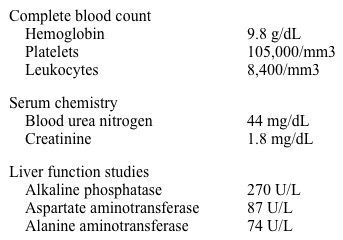A 66-year-old man comes to the hospital due to 2 days of fever, chills, fatigue, and malaise. He has had no chest pain, cough, diarrhea, or dysuria. The patient has a history of lymphoma and underwent a splenectomy 6 years ago. Prior to the splenectomy, he received vaccinations against Neisseria meningitidis and Streptococcus pneumoniae. Six months ago, the patient returned from a 2-week trip to India during which he did not take antimalarial prophylaxis. He has no known ill contacts. The patient lives in Massachusetts and is a professor at a local college.
Temperature is 38.6 C (101.5 F) , blood pressure is 122/70 mm Hg, and pulse is 110/min and regular. The patient has mild respiratory distress. The oropharynx is dry without lesions. Lung examination reveals bilateral coarse crackles. The abdomen is soft and mildly tender throughout. He has no skin rash.
Laboratory results are as follows:
A chest x-ray reveals diffuse bilateral infiltrates. A peripheral blood smear shows intraerythrocytic inclusions (see exhibit) .
Which of the following is the most likely organism causing this patient's illness?
Definitions:
Pollution
The contamination of air, water, or soil by substances that are harmful to living organisms and the environment.
Fine and Ultrafine Particles
Tiny particles suspended in the air, smaller than 2.5 micrometers, which can penetrate deep into the lungs and are associated with health risks.
Coal Dust
Fine powdered form of coal, which is considered a hazardous material due to its potential to cause respiratory issues and its contribution to air pollution.
Insecticide Dust
A powdered substance containing chemicals used to kill insects, often applied to crops or within homes to control pests.
Q6: A 68-year-old man is seen for follow-up
Q60: A 27-year-old man comes to the office
Q145: A 50-year-old woman comes to the office
Q200: A 59-year-old man comes to the physician
Q202: A 53-year-old man is seen for a
Q369: The graphs of <img src="https://d2lvgg3v3hfg70.cloudfront.net/TBX8673/.jpg" alt="The graphs
Q470: A 62-year-old man complains of a black
Q569: A 65-year-old Asian woman comes to the
Q645: A 26-year-old man is brought to the
Q815: A 76-year-old man comes to the office